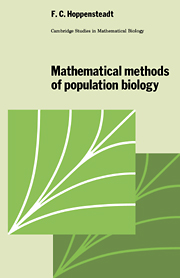4 - Perturbation methods
Published online by Cambridge University Press: 04 May 2010
Summary
As we have seen in the Fibonacci model (Section 2.1), a closed form for a model's solution does not necessarily provide useful information; additional analysis of the solution may be required. In that example, we found the approximate behavior of the population's birth rate after a large number of generations (n ≥ 5) and made precise the sense in which the approximation is made. In many problems, for example those arising in genetics, it is not even possible to obtain a formula for the solution. However, when detailed information is available for certain combinations of parameters, it is frequently possible to derive useful information for nearby values. These are referred to as perturbation methods. Examples from genetics and epidemics will be used here to present several perturbation methods that are basic tools in applied mathematics. These problems also focus on deducing the evolution and long-time behavior of biological systems.
Approximations to dynamic processes: multiple-time-scale methods
In most biological and physical systems, various aspects of a phenomenon take place on various time scales. For example, a population's genetic structure changes as a result of sampling of the gene pool at reproduction times, so these changes occur on a fast time scale compared to infrequent mutations and slight differences between fertility and survivability among genotypes, which are significant only over very long (or slow) time scales.
The most widely used multiple-scale methods fall roughly into two classes: those for which rapid changes occur initially followed by slow long-time-scale changes, and those for which there is persistent rapidly oscillating behavior that is modulated by slowly changing components.
- Type
- Chapter
- Information
- Mathematical Methods of Population Biology , pp. 75 - 91Publisher: Cambridge University PressPrint publication year: 1982



